Spatial and Temporal Inversion of Land Surface Temperature along Coastal Cities in Arid Regions
Abstract
:1. Introduction
- Assess the land cover change in the study area, including built-up areas, water bodies, vegetation, and desert areas for the last five decades (1976–2017);
- Understand how the LST changed spatially and temporally in the study area;
- Examine the changes of LST between daytime and nighttime in the summer and winter seasons.
2. Methodology Framework
3. Data Acquisition
3.1. Study Area
3.2. Data Processing
4. Urbanization and Change Detection
5. LST Retrieving from Satellite Images
- Step 1: Convert the digital number (DN) to the top of atmosphere (TOA) radiance value;
- Lλ: top of atmosphere (TOA) radiance value (W/(m2 sr μm));
- ML: band-specific multiplicative rescaling factor;
- AL: band-specific additive rescaling factor; and
- Qcal: quantized and calibrated standard product pixel values (DN of bands 10 and 11).
- BT: TOA brightness temperature (Kelvin);
- Lλ: TOA spectral radiance (W/(m2 sr μm));
- K1: band-specific thermal conversion constants (W/(m2 sr μm));
- K2: band-specific thermal conversion constant (Kelvin); and
- Ln: the natural logarithm.
- LSE: land surface emissivity;
- PV: proportion of vegetation; and
- NDVI: normalized difference vegetation index.
- LST: land surface temperature (Celsius);
- BT: TOA brightness temperature (Celsius); and
- λ: wavelength of emitted radiance (10.60 to 12.51 µm of bands 10 and 11).
- p is calculated using Equation (7).
- h: Planck’s constant (6.626 × 10−34 Js);
- s: Boltzmann constant (1.380 × 10−23 J/K); and
- c: velocity of light (2.998 × 108 m/s).
- Step 2: Convert the spectral radiance to the brightness temperature (BT);
- Step 3: Calculate the emissivity and generate the NDVI;
- Step 4: Retrieve the LST maps.
6. Near-Surface Temperature versus LST
6.1. Temporal Variations of Near-Surface Temperature since the 1970s
6.2. Quantitative Comparision of Near-Surface Temperature and LST
7. Wind Pattern Analysis
8. Multi-Temporal LST Profiling and Interpretation
8.1. Spatial Assessment of LST
8.1.1. Summer Profiling
8.1.2. Zonal Statistics
- The areas of the industrial building have generally higher LST than areas of residential buildings;
- The presence of vegetation in any area, regardless of its proximity distance from the coastline, could reduce the LST;
- The presence of sand in any area, regardless of its proximity distance from the coastline, could increase the LST compared to areas that are fully urbanized (whether industrial or residential buildings);
- The LST of the bare land sand increases as the distance from the coastline increases.
8.1.3. Winter Profiling
8.2. Temporal Evolution of LST
8.2.1. Daytime LST
8.2.2. Nighttime LST
9. Conclusions
- Contrary to the observed UHI in other regions, the LST in our study area increases spatially as we move away from urban areas. This observation could be characterized as a spatial inversion of UHI. The possible reason behind this is that the bare land in the study area is now sand, vegetation, and high-rise buildings, which provide an extra shading to their surrounding area and replaced those bare lands. Moreover, the effect of the gulf breeze coming from the northwest might play a role in cooling the hot air in the urban areas close to the coast, thus, making them cooler than rural areas.
- The analysis of the study did not show any significant changes in the daytime LST, neither in summer nor in winter. At the same time, the nighttime LST increased temporally in the summer seasons by 17% since 2000. Nevertheless, the nighttime LST in the winter seasons showed somehow stable records. This observation could be characterized by the temporal inversion of UHI.
- The zonal statistics of the summer LST showed that areas with industrial buildings have generally higher temperatures than areas with residential buildings. Furthermore, the presence of bare sand in urban areas has a relatively higher LST than in areas that are fully urbanized (facilities with/out vegetation).
Author Contributions
Funding
Institutional Review Board Statement
Informed Consent Statement
Data Availability Statement
Conflicts of Interest
References
- Liu, Z.; Wang, Y.; Li, Z.; Peng, J. Impervious surface impact on water quality in the process of rapid urbanization in Shenzhen, China. Environ. Earth Sci. 2013, 68, 2365–2373. [Google Scholar] [CrossRef]
- Nelken, K.; Leziak, K. The seasonal variability of the amount of global solar radiation reaching the ground in urban and rural areas on the example of Warsaw and Belsk. Misc. Geogr. 2016, 20, 29–37. [Google Scholar] [CrossRef] [Green Version]
- Robaa, S.M. A study of ultraviolet solar radiation at Cairo urban area, Egypt. Sol. Energy 2004, 77, 251–259. [Google Scholar] [CrossRef]
- Robaa, S.M. Urban-rural solar radiation loss in the atmosphere of Greater Cairo region, Egypt. Energy Convers. Manag. 2009, 50, 194–202. [Google Scholar] [CrossRef]
- Park, H.-S. Features of the heat island in seoul and its surrounding cities. Atmos. Environ. 1986, 20, 1859–1866. [Google Scholar] [CrossRef]
- Middel, A.; Brazel, A.J.; Kaplana, S.; Myint, S.W. Daytime cooling efficiency and diurnal energy balance in Phoenix, Arizona, USA. Clim. Res. 2012, 54, 21–34. [Google Scholar] [CrossRef] [Green Version]
- Kato, S.; Yamaguchi, Y. Estimation of storage heat flux in an urban area using ASTER data. Remote Sens. Environ. 2007, 110, 1–17. [Google Scholar] [CrossRef]
- Lazzarini, M.; Marpu, P.R.; Ghedira, H. Temperature-land cover interactions: The inversion of urban heat island phenomenon in desert city areas. Remote Sens. Environ. 2013, 130, 136–152. [Google Scholar] [CrossRef]
- Rivera, E.; Antonio-Némiga, X.; Origel-Gutiérrez, G.; Sarricolea, P.; Adame-Martínez, S. Spatiotemporal analysis of the atmospheric and surface urban heat islands of the Metropolitan Area of Toluca, Mexico. Environ. Earth Sci. 2017, 76, 1–14. [Google Scholar] [CrossRef]
- Schwarz, N.; Lautenbach, S.; Seppelt, R. Exploring indicators for quantifying surface urban heat islands of European cities with MODIS land surface temperatures. Remote Sens. Environ. 2011, 115, 3175–3186. [Google Scholar] [CrossRef]
- Phelan, P.E.; Kaloush, K.; Miner, M.; Golden, J.; Phelan, B.; Silva, H., III; Taylor, R.A. Urban Heat Island: Mechanisms, Implications, and Possible Remedies. Annu. Rev. Environ. Resour. 2015, 40, 285–307. [Google Scholar] [CrossRef]
- Rizwan, A.M.; Dennis, L.Y.; Chunho, L.I.U. A review on the generation, determination and mitigation of Urban Heat Island. J. Environ. Sci. 2008, 20, 120–128. [Google Scholar] [CrossRef]
- Amirtham, L.R. Urbanization and its impact on urban heat Island intensity in Chennai Metropolitan Area, India. Indian J. Sci. Technol. 2016, 9, 1–8. [Google Scholar] [CrossRef] [Green Version]
- Thomas, G.; Zachariah, E. Urban Heat Island in a Tropical City Interlaced by Wetlands. J. Environ. Sci. 2011, 5, 234–240. [Google Scholar]
- Yao, R.; Wang, L.; Gui, X.; Zheng, Y.; Zhang, H.; Huang, X. Urbanization effects on vegetation and surface urban heat islands in China’s Yangtze River Basin. Remote Sens. 2017, 9, 540. [Google Scholar] [CrossRef] [Green Version]
- Li, G.; Zhang, X.; Mirzaei, P.A.; Zhang, J.; Zhao, Z. Urban heat island effect of a typical valley city in China: Responds to the global warming and rapid urbanization. Sustain. Cities Soc. 2018, 38, 736–745. [Google Scholar] [CrossRef]
- Su, Y.F.; Foody, G.M.; Cheng, K.S. Spatial non-stationarity in the relationships between land cover and surface temperature in an urban heat island and its impacts on thermally sensitive populations. Landsc. Urban Plan. 2012, 107, 172–180. [Google Scholar] [CrossRef]
- Coseo, P.; Larsen, L. Accurate characterization of land cover in urban environments: Determining the importance of including obscured impervious surfaces in urban heat island models. Atmosphere 2019, 10, 347. [Google Scholar] [CrossRef] [Green Version]
- Chen, T.; Sun, A.; Niu, R. Effect of land cover fractions on changes in surface urban heat islands using landsat time-series images. Int. J. Environ. Res. Public Health 2019, 16, 971. [Google Scholar] [CrossRef] [Green Version]
- Li, B.; Liu, Z.; Nan, Y.; Li, S.; Yang, Y. Comparative analysis of urban heat island intensities in Chinese, Russian, and DPRK regions across the transnational urban agglomeration of the Tumen River in Northeast Asia. Sustainability 2018, 10, 2637. [Google Scholar] [CrossRef] [Green Version]
- Filho, W.L.; Icaza, L.E.; Emanche, V.O.; Al-Amin, A.Q. An evidence-based review of impacts, strategies and tools to mitigate urban heat islands. Int. J. Environ. Res. Public Health 2017, 14, 1600. [Google Scholar] [CrossRef] [PubMed] [Green Version]
- Beaudoin, M.; Gosselin, P. An effective public health program to reduce urban heat islands in Québec, Canada. Rev. Panam. Salud Publica/Pan Am. J. Public Health 2016, 40, 160–166. [Google Scholar]
- Van Der Hoeven, F.; Wandl, A. Amsterwarm: Mapping the landuse, health and energy-efficiency implications of the Amsterdam urban heat island. Build. Serv. Eng. Res. Technol. 2015, 36, 67–88. [Google Scholar] [CrossRef]
- Che-Ani, A.I.; Shahmohamadi, P.; Sairi, A.; Mohd-Nor, M.F.I.; Zain, M.F.M.; Surat, M. Mitigating the urban heat island effect: Some points without altering existing city planning. Eur. J. Sci. Res. 2009, 35, 204–216. [Google Scholar]
- Debbage, N.; Shepherd, J.M. The urban heat island effect and city contiguity. Comput. Environ. Urban Syst. 2015, 54, 181–194. [Google Scholar] [CrossRef]
- Sharma, R.; Joshi, P.K. Identifying seasonal heat islands in urban settings of Delhi (India) using remotely sensed data—An anomaly based approach. Urban Clim. 2014, 9, 19–34. [Google Scholar] [CrossRef]
- Bokaie, M.; Zarkesh, M.K.; Arasteh, P.D.; Hosseini, A. Assessment of Urban Heat Island based on the relationship between land surface temperature and Land Use/Land Cover in Tehran. Sustain. Cities Soc. 2016, 23, 94–104. [Google Scholar] [CrossRef]
- Mathew, A.; Khandelwal, S.; Kaul, N. Analysis of diurnal surface temperature variations for the assessment of surface urban heat island effect over Indian cities. Energy Build. 2018, 159, 271–295. [Google Scholar] [CrossRef]
- Cristóbal, J.; Jiménez-Muñoz, J.C.; Sobrino, J.A.; Ninyerola, M.; Pons, X. Improvements in land surface temperature retrieval from the Landsat series thermal band using water vapor and air temperature. J. Geophys. Res. Atmos. 2009, 114, 1–16. [Google Scholar] [CrossRef]
- Kafer, P.S.; Rolim, S.B.A.; Iglesias, M.L.; da Rocha, N.S.; Diaz, L.R. Land Surface Temperature Retrieval by LANDSAT 8 Thermal Band: Applications of Laboratory and Field Measurements. IEEE J. Sel. Top. Appl. Earth Obs. Remote Sens. 2019, 12, 2332–2341. [Google Scholar] [CrossRef]
- Li, F.; Jackson, T.J.; Kustas, W.P.; Schmugge, T.J.; French, A.N.; Cosh, M.H.; Bindlish, R. Deriving land surface temperature from Landsat 5 and 7 during SMEX02/SMACEX. Remote Sens. Environ. 2004, 92, 521–534. [Google Scholar] [CrossRef]
- Gui, X.; Wang, L.; Yao, R.; Yu, D.; Li, C. Investigating the urbanization process and its impact on vegetation change and urban heat island in Wuhan, China. Environ. Sci. Pollut. Res. 2019, 26, 30808–30825. [Google Scholar] [CrossRef] [PubMed]
- Katpatal, Y.B.; Kute, A.; Satapathy, D.R. Surface- and air-temperature studies in relation to land use/land cover of nagpur urban area using landsat 5 TM data. J. Urban Plan. Dev. 2008, 134, 110–118. [Google Scholar] [CrossRef]
- Kotharkar, R.; Bagade, A. Evaluating urban heat island in the critical local climate zones of an Indian city. Landsc. Urban Plan. 2018, 169, 92–104. [Google Scholar] [CrossRef]
- Mohammad, P.; Goswami, A.; Bonafoni, S. The impact of the land cover dynamics on surface urban heat island variations in semi-arid cities: A case study in Ahmedabad City, India, using multi-sensor/source data. Sensors 2019, 19, 3701. [Google Scholar] [CrossRef] [PubMed] [Green Version]
- Ochola, E.M.; Fakharizadehshirazi, E.; Adimo, A.O.; Mukundi, J.B.; Wesonga, J.M.; Sodoudi, S. Inter-local climate zone differentiation of land surface temperatures for Management of Urban Heat in Nairobi City, Kenya. Urban Clim. 2020, 31, 100540. [Google Scholar] [CrossRef]
- Qiao, Z.; Liu, L.; Qin, Y.; Xu, X.; Wang, B.; Liu, Z. The impact of urban renewal on land surface temperature changes: A case study in the main city of Guangzhou, China. Remote Sens. 2020, 12, 794. [Google Scholar] [CrossRef] [Green Version]
- Golden, J.S.; Kaloush, K.E. Mesoscale and microscale evaluation of surface pavement impacts on the urban heat island effects. Int. J. Pavement Eng. 2006, 7, 37–52. [Google Scholar] [CrossRef]
- Abulibdeh, A. Analysis of urban heat island characteristics and mitigation strategies for eight arid and semi-arid gulf region cities. Environ. Earth Sci. 2021, 80, 1–26. [Google Scholar] [CrossRef]
- Mohamed, M.; Othman, A.; Abotalib, A.Z.; Majrashi, A. Urban heat island effects on megacities in desert environments using spatial network analysis and remote sensing data: A case study from western Saudi Arabia. Remote Sens. 2021, 13, 1941. [Google Scholar] [CrossRef]
- Bala, R.; Prasad, R.; Pratap Yadav, V. A comparative analysis of day and night land surface temperature in two semi-arid cities using satellite images sampled in different seasons. Adv. Sp. Res. 2020, 66, 412–425. [Google Scholar] [CrossRef]
- He, B.J. Potentials of meteorological characteristics and synoptic conditions to mitigate urban heat island effects. Urban Clim. 2018, 24, 26–33. [Google Scholar] [CrossRef]
- Sakakibara, Y.; Matsui, E. Relation between heat island intensity and city size indices/urban canopy characteristics in settlements of Nagano basin, Japan. Geogr. Rev. Jpn. 2005, 78, 812–824. [Google Scholar] [CrossRef] [Green Version]
- Zak, M.; Nita, I.A.; Dumitrescu, A.; Cheval, S. Influence of synoptic scale atmospheric circulation on the development of urban heat island in Prague and Bucharest. Urban Clim. 2020, 34, 100681. [Google Scholar] [CrossRef]
- He, B.J.; Wang, J.; Liu, H.; Ulpiani, G. Localized synergies between heat waves and urban heat islands: Implications on human thermal comfort and urban heat management. Environ. Res. 2021, 193, 110584. [Google Scholar] [CrossRef]
- He, B.J.; Ding, L.; Prasad, D. Relationships among local-scale urban morphology, urban ventilation, urban heat island and outdoor thermal comfort under sea breeze influence. Sustain. Cities Soc. 2020, 60, 102289. [Google Scholar] [CrossRef]
- He, B.J.; Ding, L.; Prasad, D. Wind-sensitive urban planning and design: Precinct ventilation performance and its potential for local warming mitigation in an open midrise gridiron precinct. J. Build. Eng. 2020, 29, 101145. [Google Scholar] [CrossRef]
- Khalil, M.; Al-Ruzouq, R.; Hamad, K.; Shanableh, A. Multi-Temporal satellite imagery for infrastructure growth assessment of Dubai City, UAE. In Proceedings of the MATEC Web of Conferences, Sharjah, United Arab Emirates, 18–20 April 2017; Volume 120, p. 09006. [Google Scholar]
- Nassar, A.K.; Alan Blackburn, G.; Duncan Whyatt, J. Developing the desert: The pace and process of urban growth in Dubai. Comput. Environ. Urban Syst. 2014, 45, 50–62. [Google Scholar] [CrossRef] [Green Version]
- Al-Ruzouq, R.; Hamad, K.; Shanableh, A.; Khalil, M. Infrastructure growth assessment of urban areas based on multi-temporal satellite images and linear features. Ann. GIS 2017, 23, 183–201. [Google Scholar] [CrossRef]
- Al-Ruzouq, R.; Yilmaz, A.G.; Shanableh, A.; Boharoun, Z.A.; Khalil, M.A.; Imteaz, M.A. Spatio-temporal analysis of urban growth and its impact on floods in Ajman City, UAE. Environ. Monit. Assess. 2019, 191, 1–21. [Google Scholar] [CrossRef]
- O’Donnell, E.M.; Schott, J.R.; Raqueno, N.G. Calibration history of Landsat thermal data. Int. Geosci. Remote Sens. Symp. 2002, 1, 27–29. [Google Scholar] [CrossRef]
- Barsi, J.A.; Schott, J.R.; Palluconi, F.D.; Helder, D.L.; Hook, S.J.; Markham, B.L.; Chander, G.; O’ Donnell, E.M. Landsat TM and ETM+ thermal band calibration. Can. J. Remote Sens. 2003, 29, 141–153. [Google Scholar] [CrossRef]
- Koutsias, N.; Pleniou, M. Comparing the spectral signal of burned surfaces between Landsat 7 ETM+ and Landsat 8 OLI sensors. Int. J. Remote Sens. 2015, 36, 3714–3732. [Google Scholar] [CrossRef]
- Gibril, M.B.A.; Bakar, S.A.; Yao, K.; Idrees, M.O.; Pradhan, B. Fusion of RADARSAT-2 and multispectral optical remote sensing data for LULC extraction in a tropical agricultural area. Geocarto Int. 2017, 32, 735–748. [Google Scholar] [CrossRef]
- Gibril, M.B.A.; Kalantar, B.; Al-Ruzouq, R.; Ueda, N.; Saeidi, V.; Shanableh, A.; Mansor, S.; Shafri, H.Z.M. Mapping heterogeneous urban landscapes from the fusion of digital surface model and unmanned aerial vehicle-based images using adaptive multiscale image segmentation and classification. Remote Sens. 2020, 12, 1081. [Google Scholar] [CrossRef] [Green Version]
- Hamedianfar, A.; Barakat, A.; Gibril, M. Large-scale urban mapping using integrated geographic object-based image analysis and artificial bee colony optimization from worldview-3 data. Int. J. Remote Sens. 2019, 40, 6796–6821. [Google Scholar] [CrossRef]
- Gibril, M.B.A.; Idrees, M.O.; Yao, K.; Shafri, H.Z.M. Integrative image segmentation optimization and machine learning approach for high quality land-use and land-cover mapping using multisource remote sensing data. J. Appl. Remote Sens. 2018, 12, 016036. [Google Scholar] [CrossRef]
- Hamedianfar, A.; Gibril, M.B.A.; Pellikka, P.K.E. Synergistic use of particle swarm optimization, artificial neural network, and extreme gradient boosting algorithms for urban LULC mapping from WorldView-3 images. Geocarto Int. 2020, 1–19. [Google Scholar] [CrossRef]
- Al-ruzouq, R.; Shanableh, A.; Mohamed, B.; Kalantar, B. Multi-scale correlation-based feature selection and random forest classification for LULC mapping from the integration of SAR and optical Sentinel imagess. In Remote Sensing Technologies and Applications in Urban Environments IV; International Society for Optics and Photonics: Washington, DC, USA, 2019. [Google Scholar] [CrossRef]
- Rouse Junior, J.W.; Hass, R.H.; Schell, J.A.; Deering, D.W. Monitoring vegetation systems in the Great Plains with ERTS. Third Earth Resour. Technol. Satell. Symp. 1974, 1, 309–317. [Google Scholar]
- McFeeters, S.K. The use of the Normalized Difference Water Index (NDWI) in the delineation of open water features. Int. J. Remote Sens. 1996, 17, 1425–1432. [Google Scholar] [CrossRef]
- Zha, Y.; Gao, J.; Ni, S. Use of normalized difference built-up index in automatically mapping urban areas from TM imagery. Int. J. Remote Sens. 2003, 24, 583–594. [Google Scholar] [CrossRef]
- Huete, A.R. A soil-adjusted vegetation index (SAVI). Remote Sens. Environ. 1988, 25, 295–309. [Google Scholar] [CrossRef]
- Ermida, S.L.; Soares, P.; Mantas, V.; Göttsche, F.M.; Trigo, I.F. Google earth engine open-source code for land surface temperature estimation from the landsat series. Remote Sens. 2020, 12, 1471. [Google Scholar] [CrossRef]
- Williamson, S.N.; Hik, D.S.; Gamon, J.A.; Jarosch, A.H.; Anslow, F.S.; Clarke, G.K.C.; Scott Rupp, T. Spring and summer monthly MODIS LST is inherently biased compared to air temperature in snow covered sub-Arctic mountains. Remote Sens. Environ. 2017, 189, 14–24. [Google Scholar] [CrossRef]
- Alqasemi, A.S.; Hereher, M.E.; Al-Quraishi, A.M.F.; Saibi, H.; Aldahan, A.; Abuelgasim, A. Retrieval of monthly maximum and minimum air temperature using MODIS aqua land surface temperature data over the United Arab Emirates. Geocarto Int. 2020, 1–18. [Google Scholar] [CrossRef]
- Sheng, L.; Tang, X.; You, H.; Gu, Q.; Hu, H. Comparison of the urban heat island intensity quantified by using air temperature and Landsat land surface temperature in Hangzhou, China. Ecol. Indic. 2017, 72, 738–746. [Google Scholar] [CrossRef]
- Good, E.J.; Ghent, D.J.; Bulgin, C.E.; Remedios, J.J. A spatiotemporal analysis of the relationship between near-surface air temperature and satellite land surface temperatures using 17 years of data from the ATSR series. J. Geophys. Res. Atmos. 2017, 122, 9185–9210. [Google Scholar] [CrossRef]
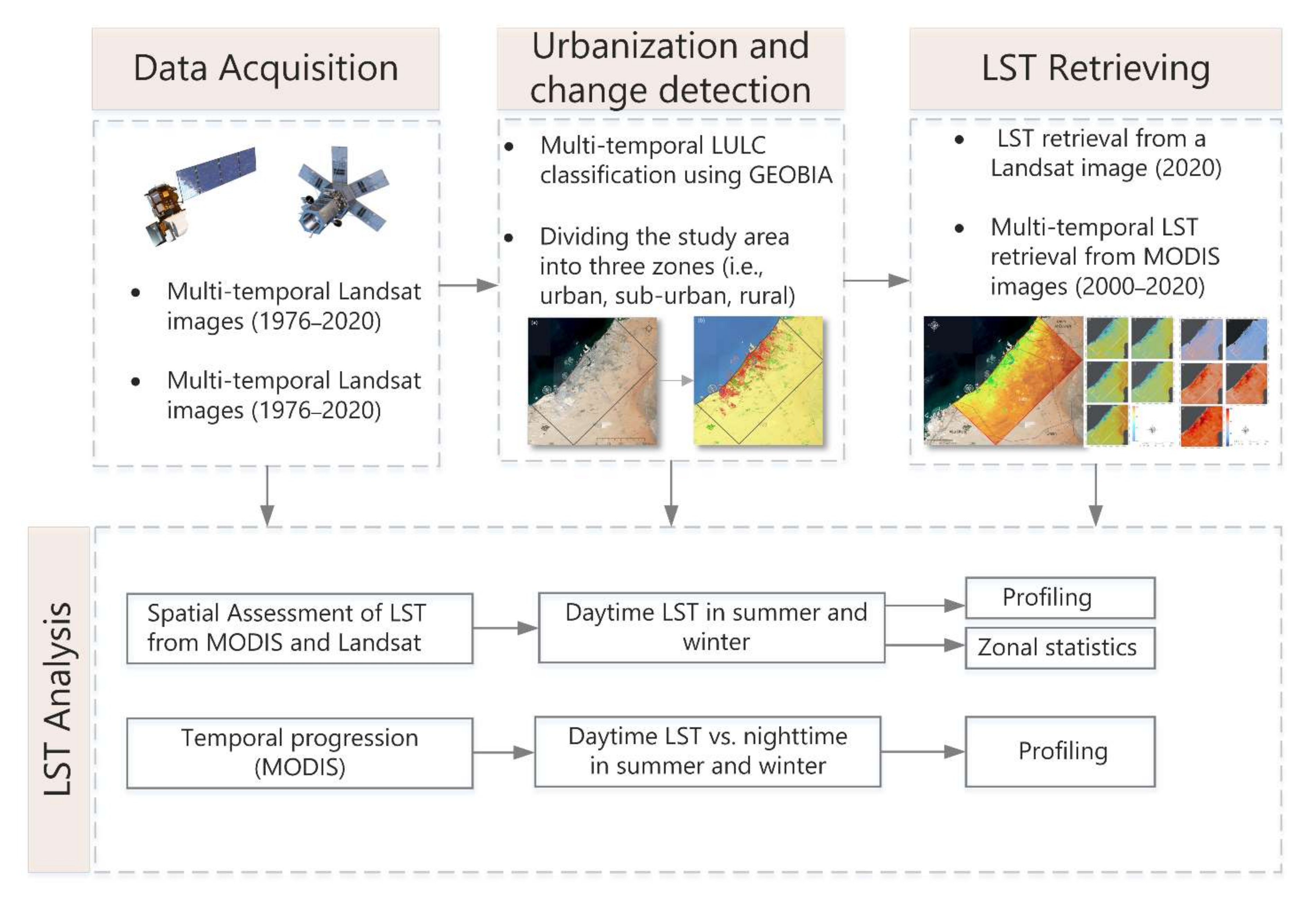
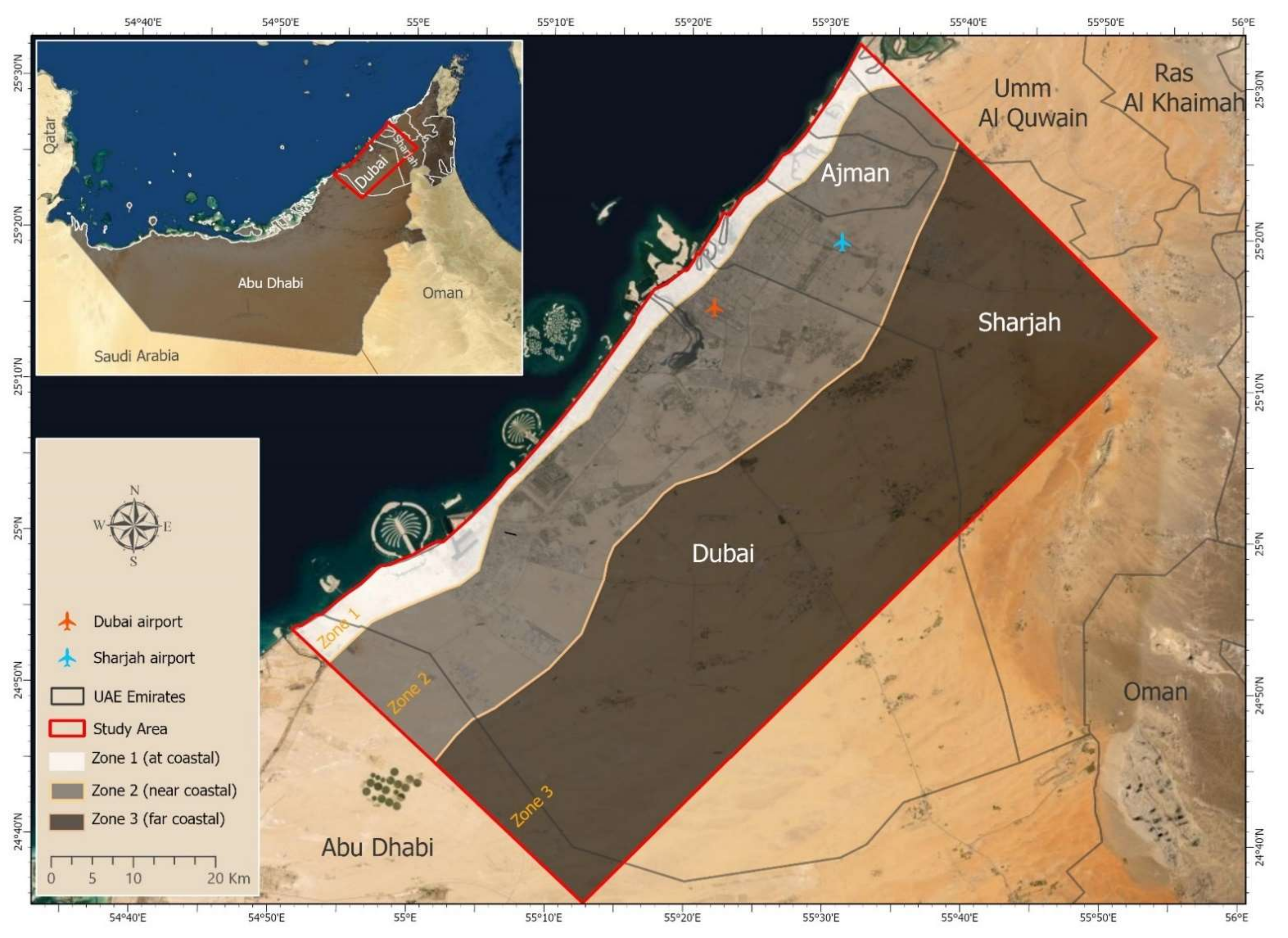



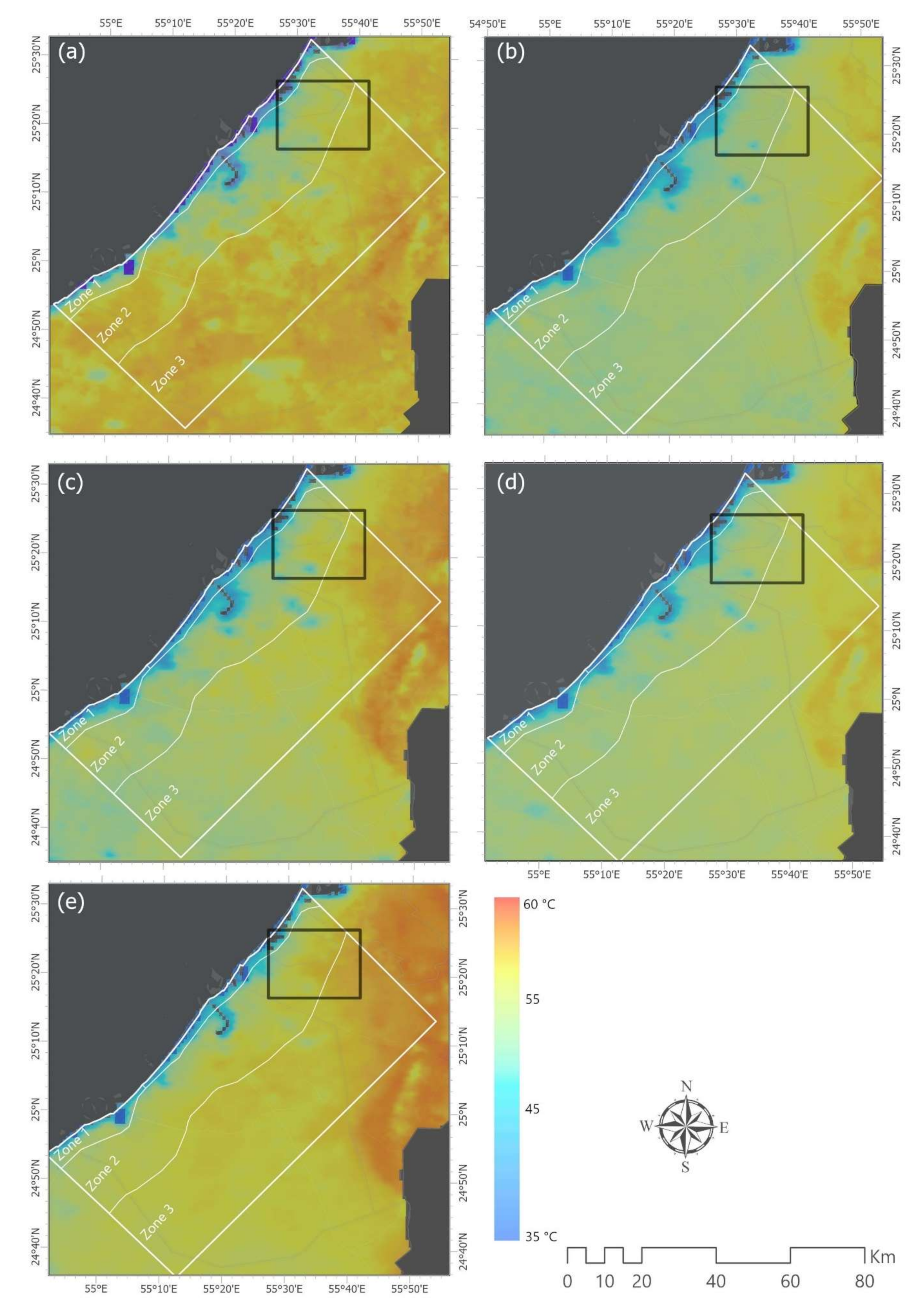

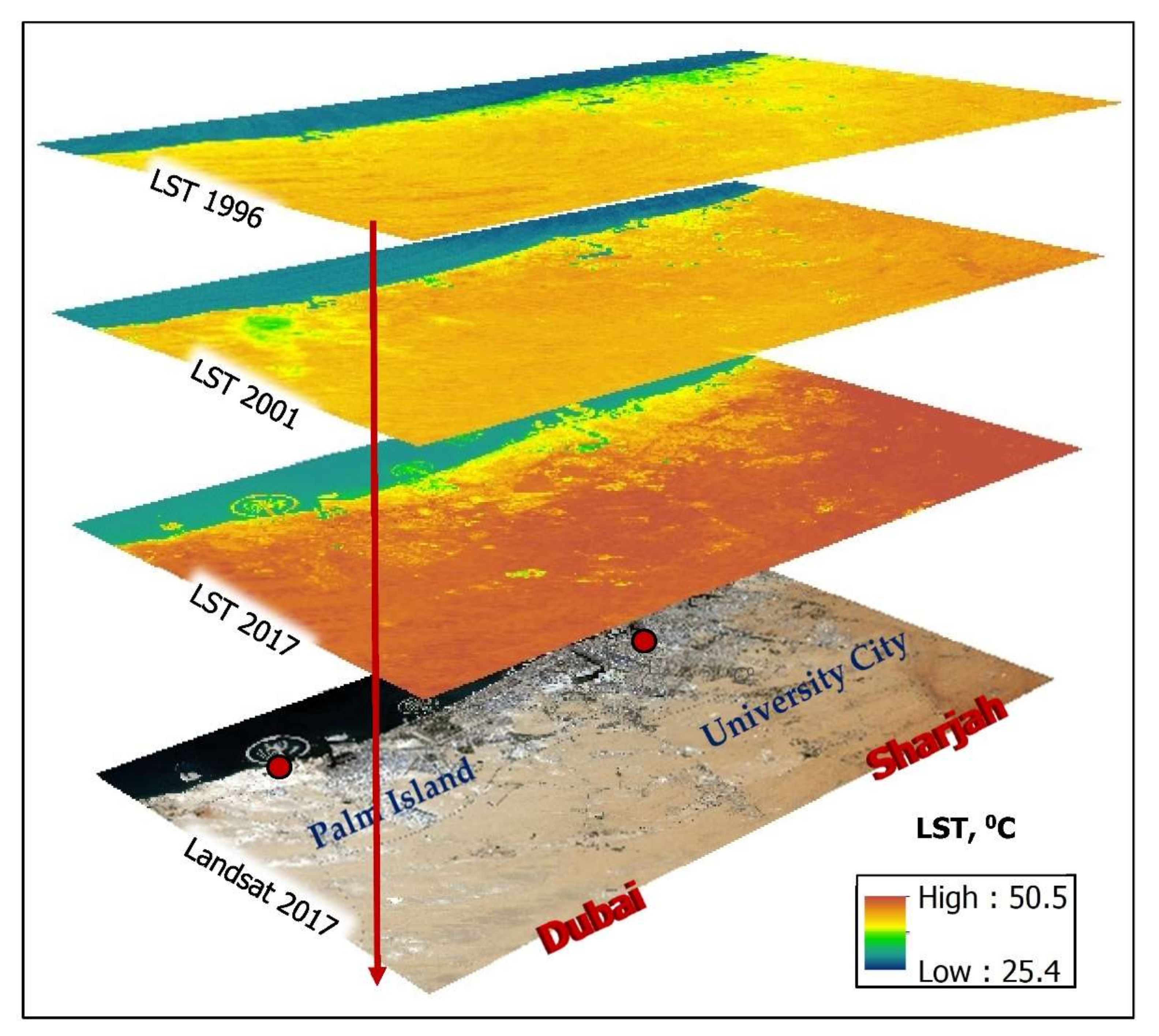
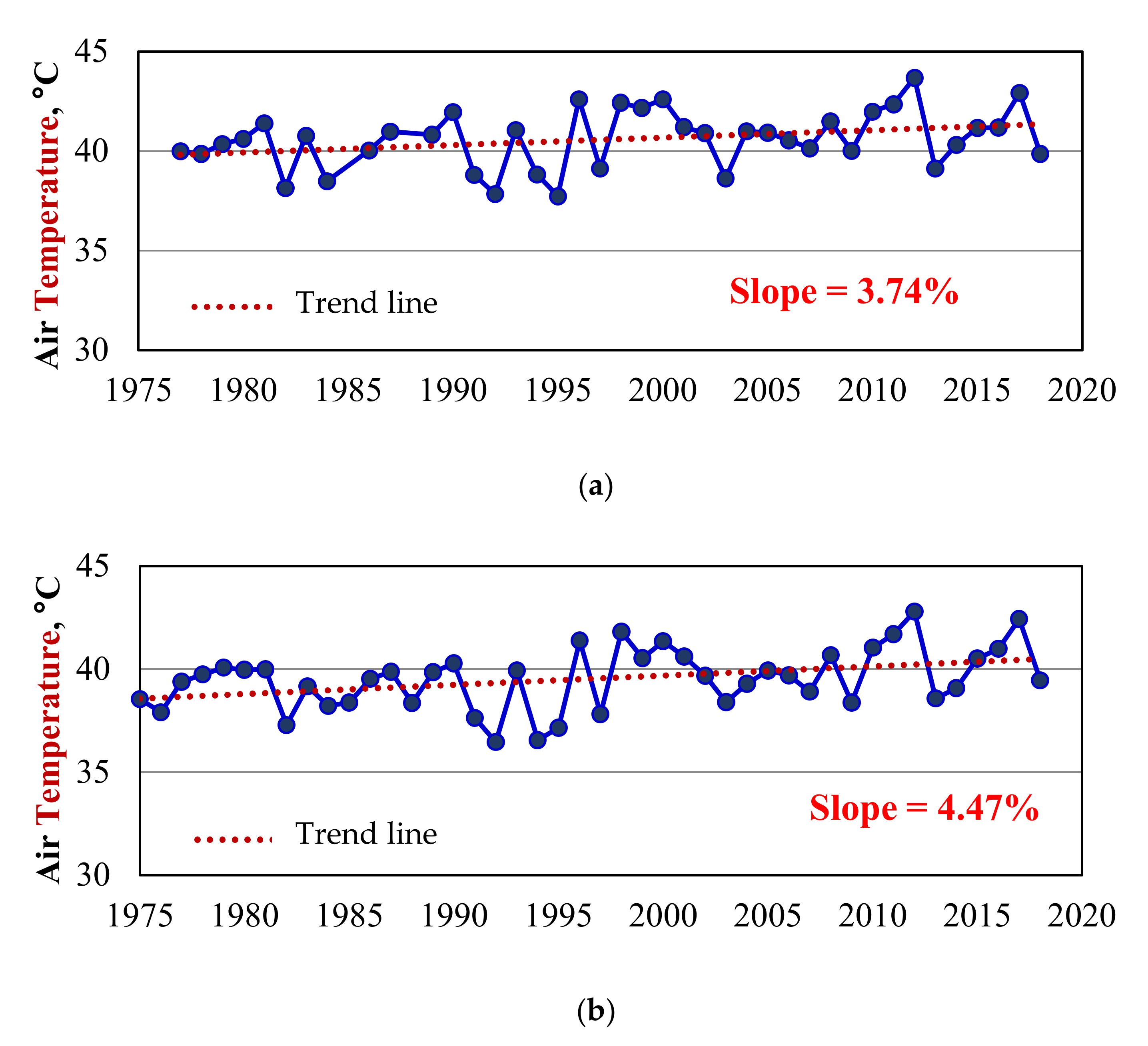

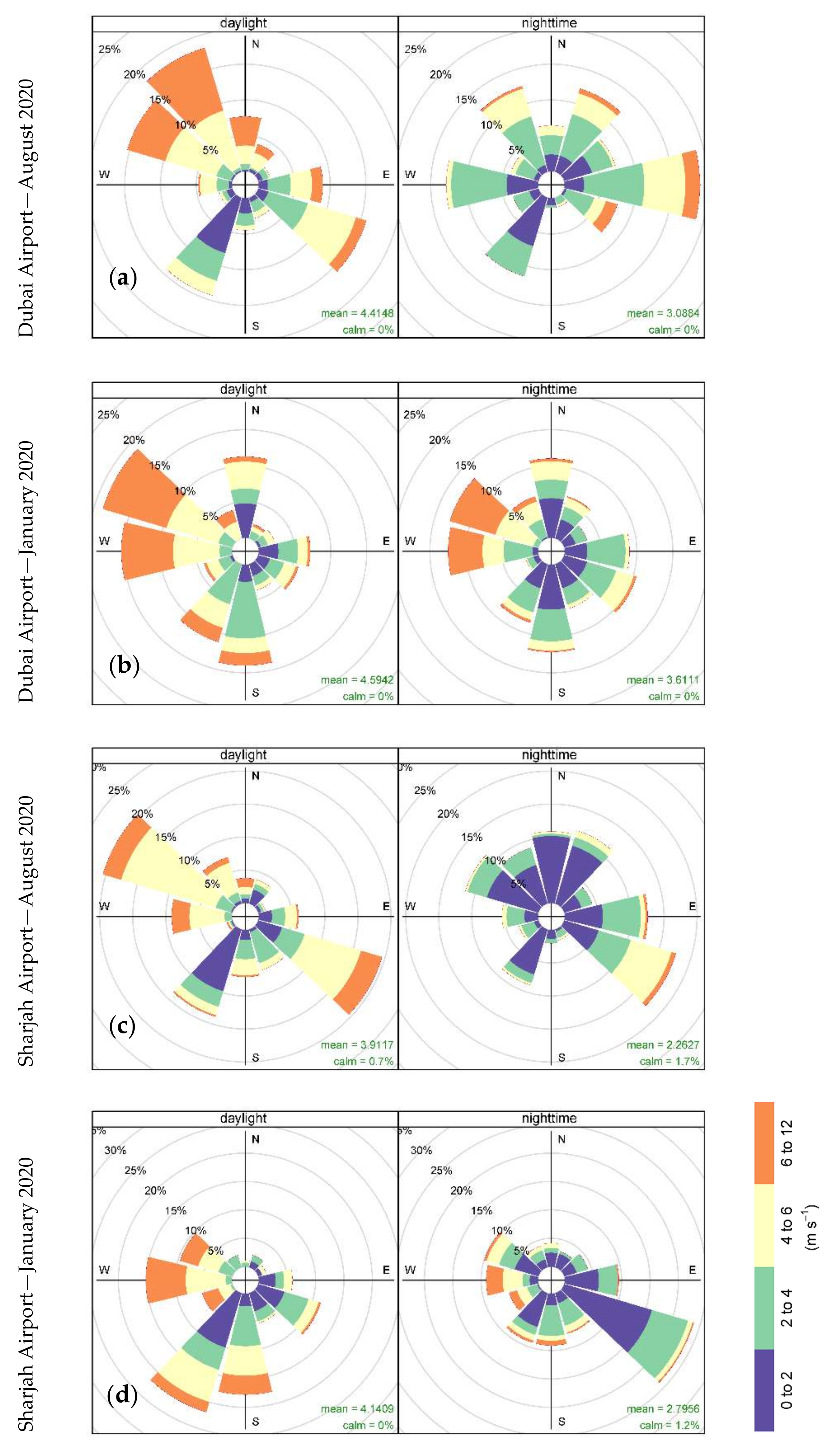


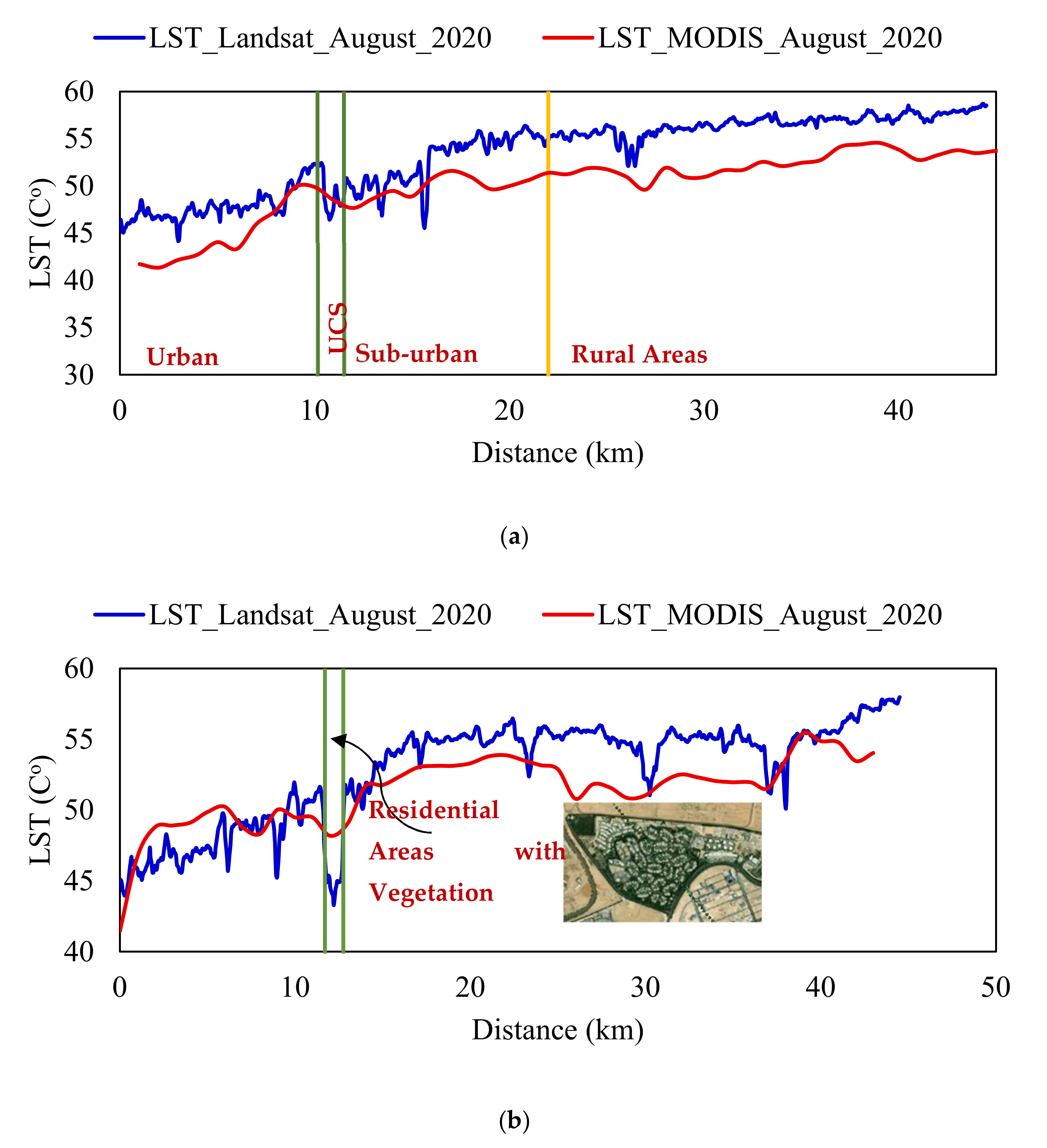

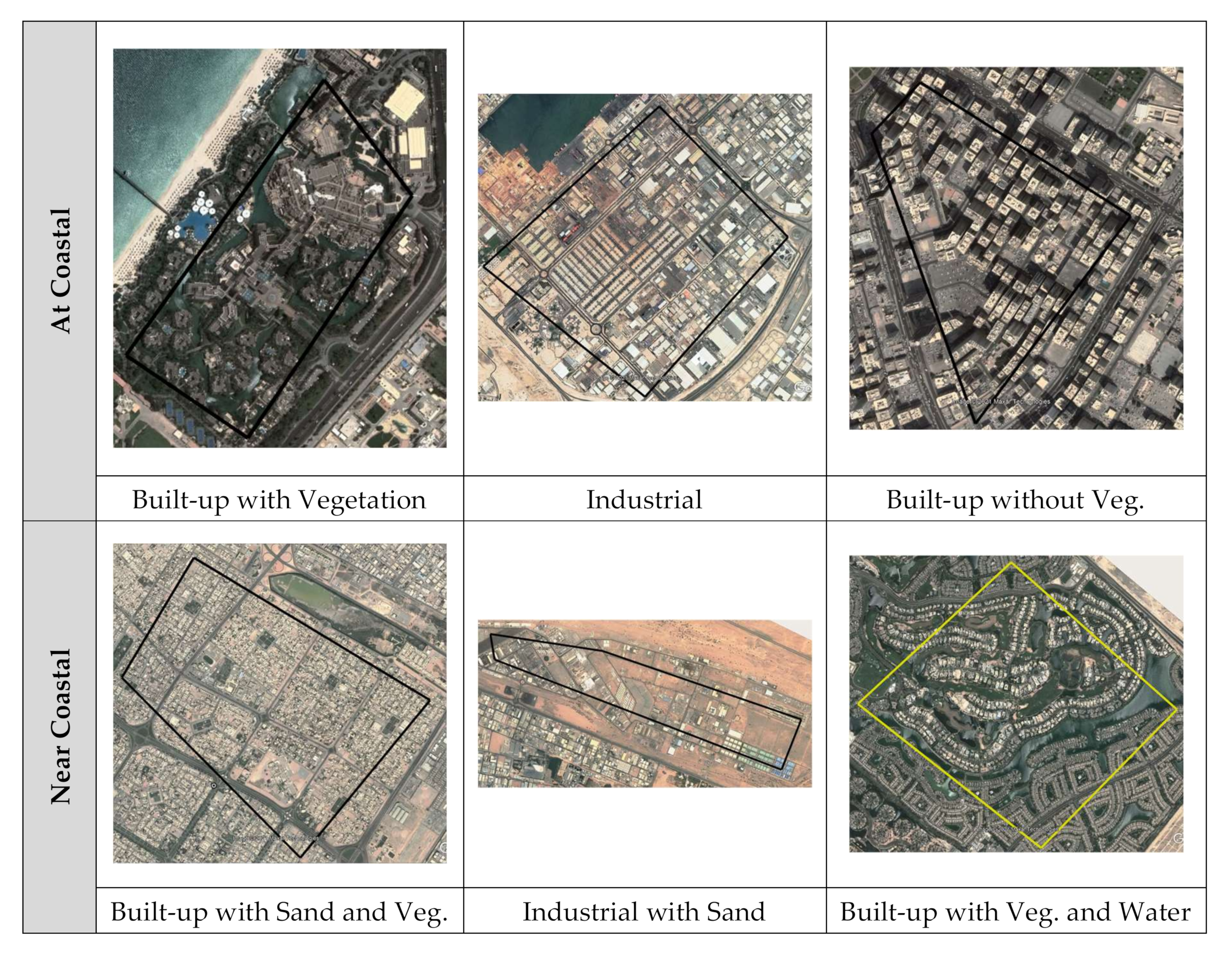
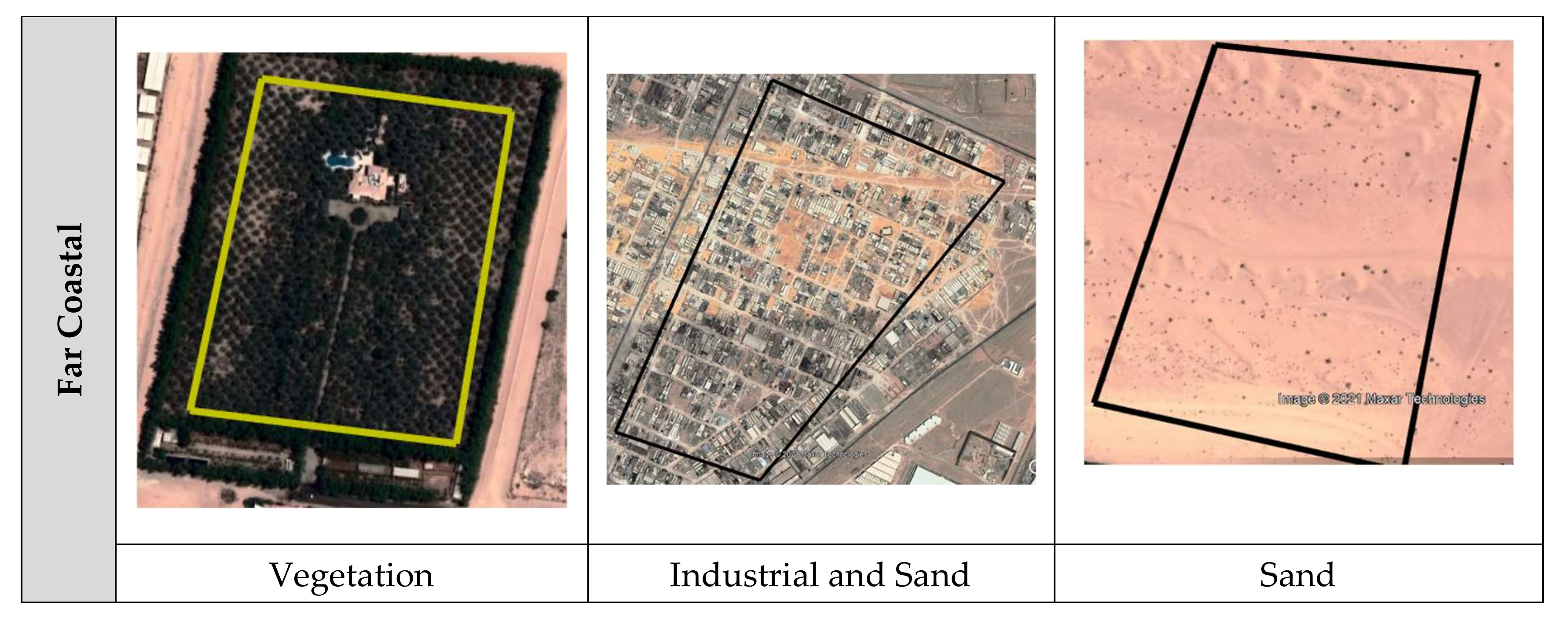
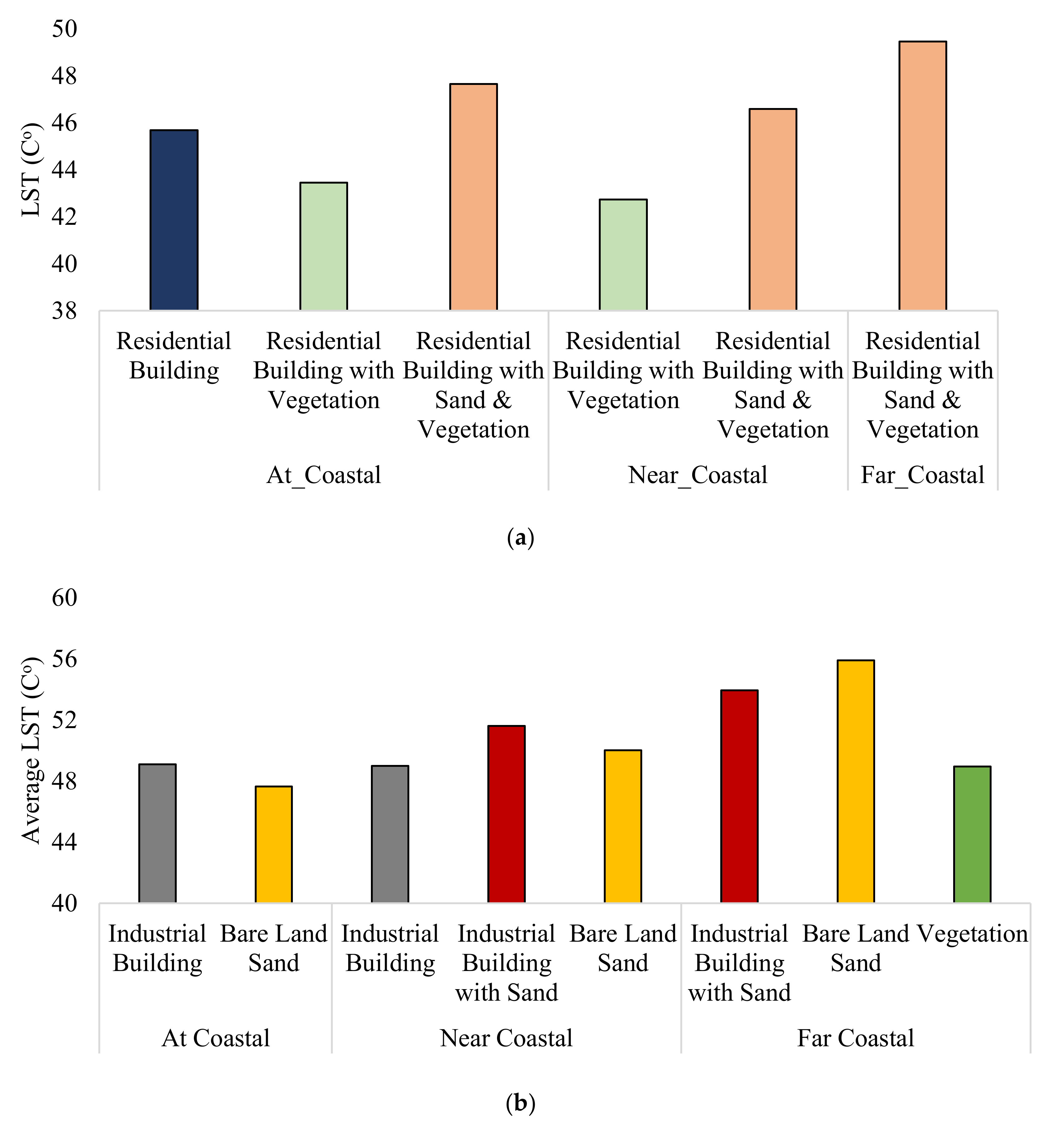
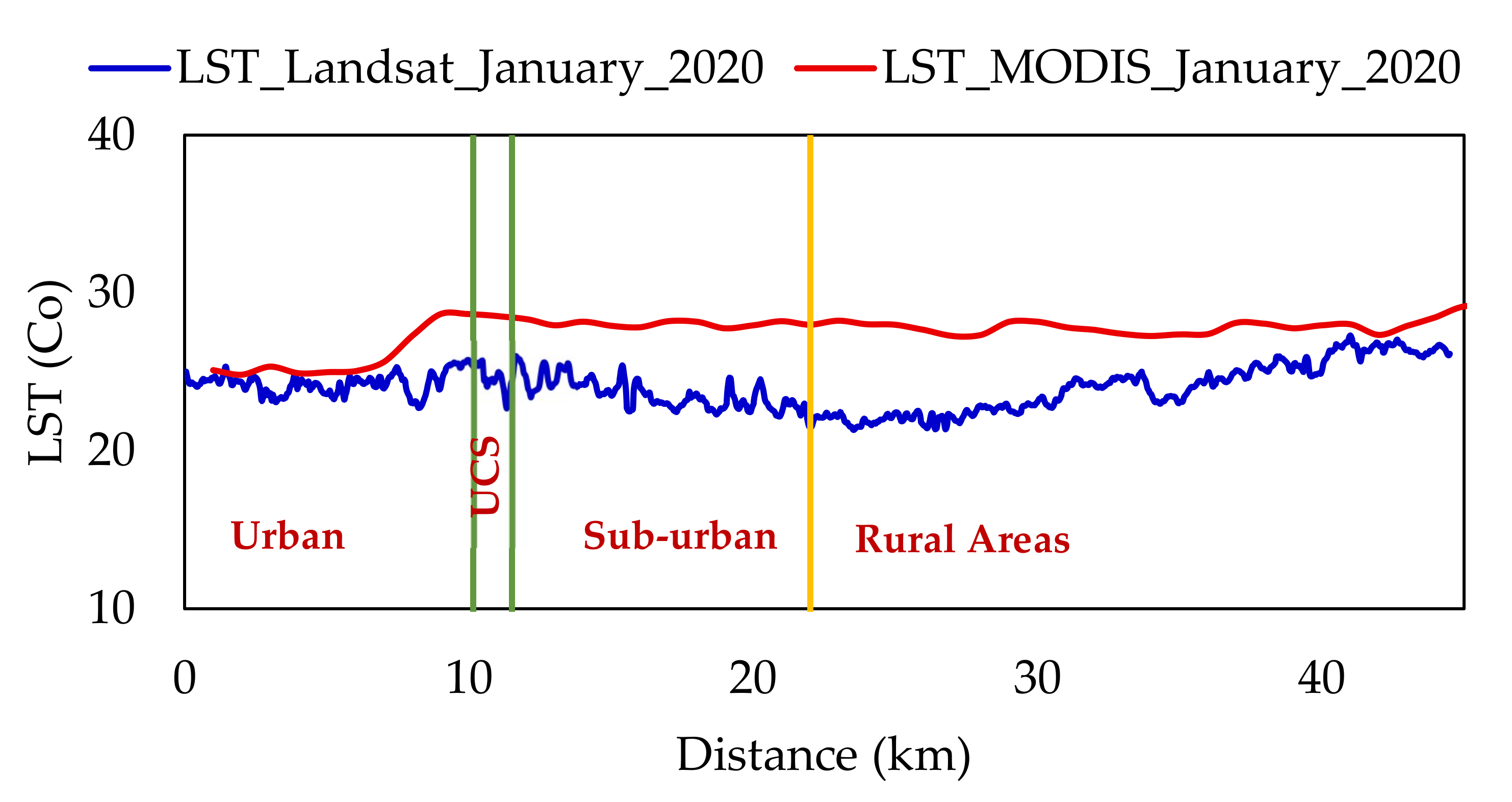
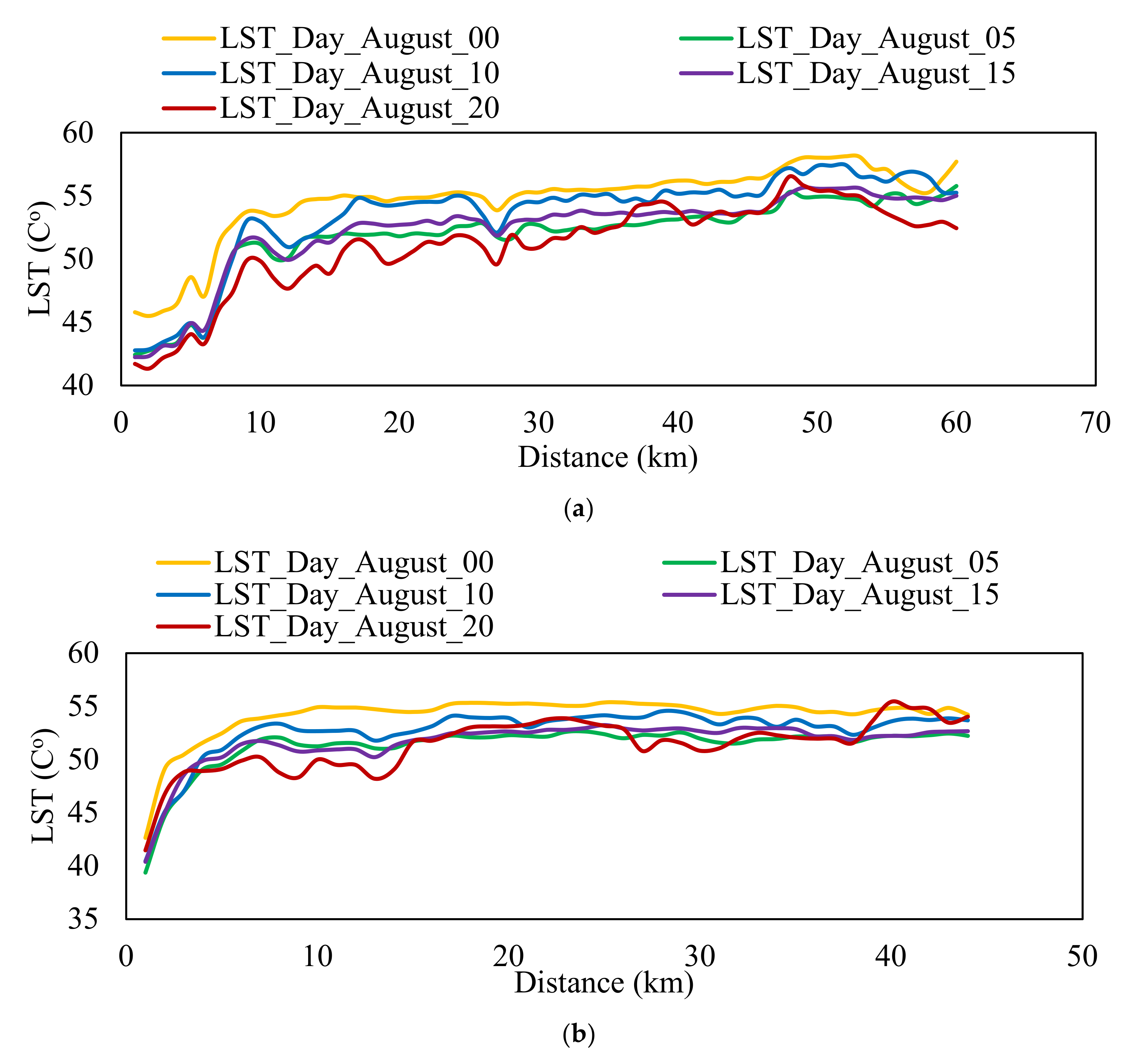
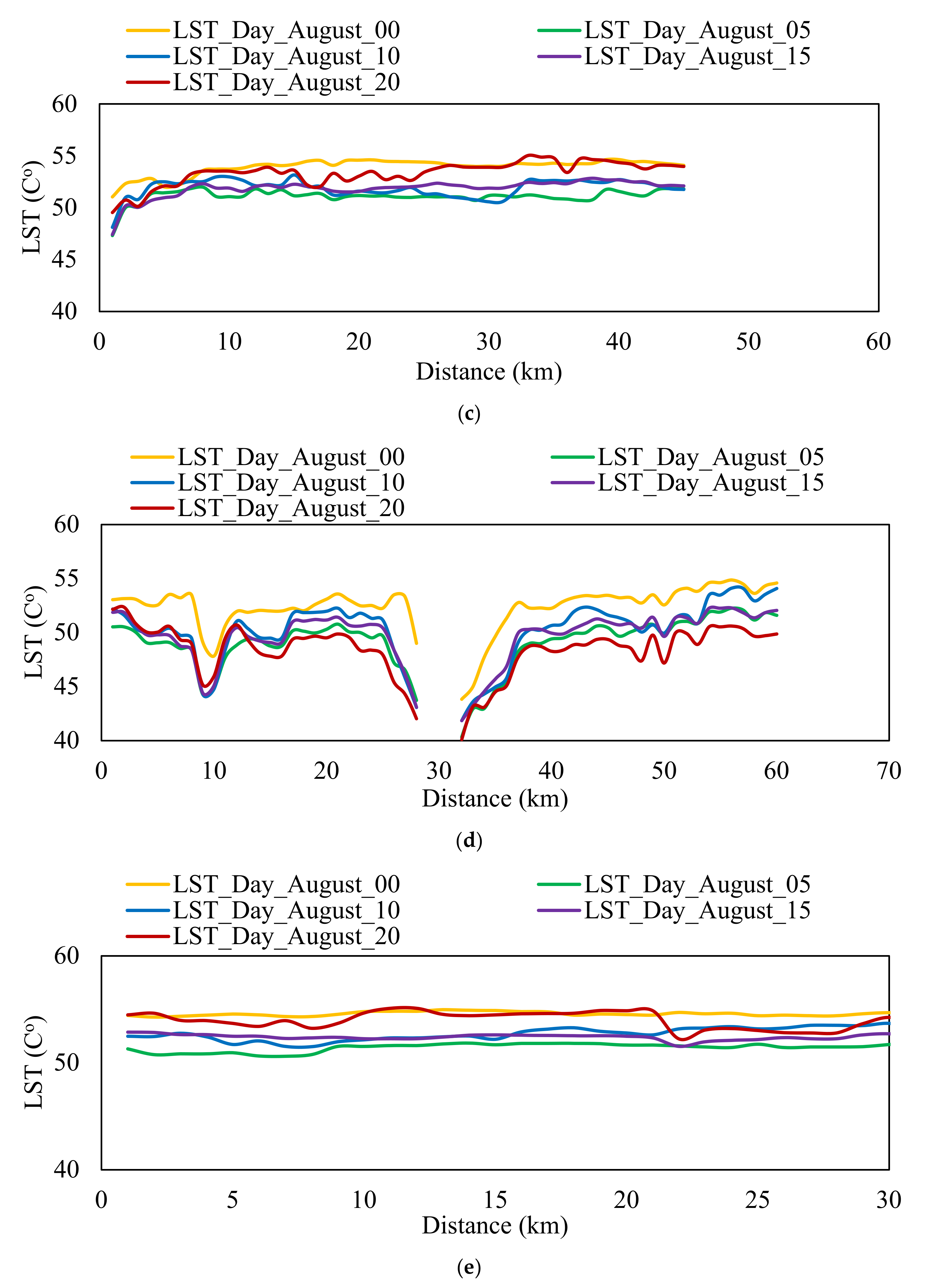
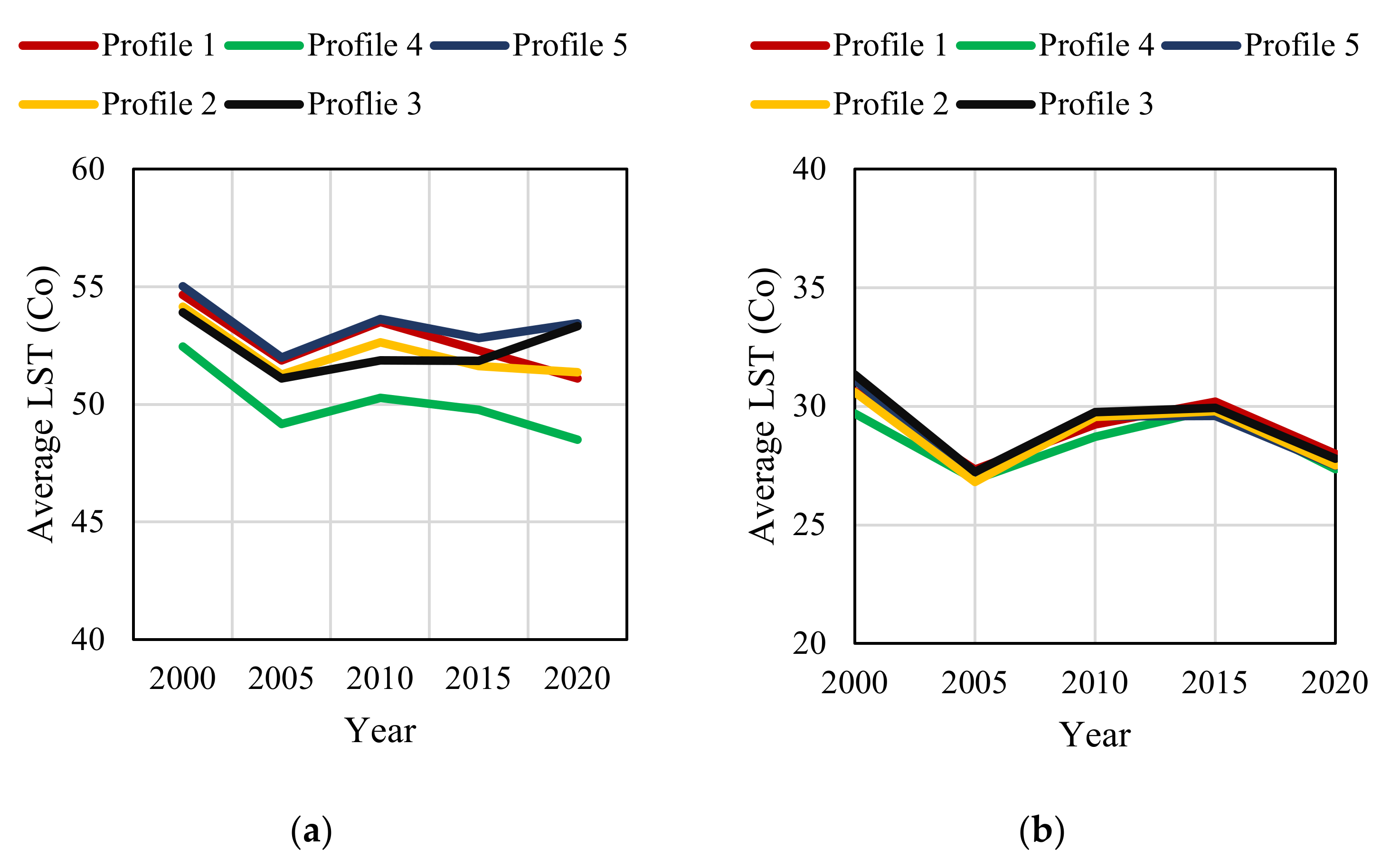
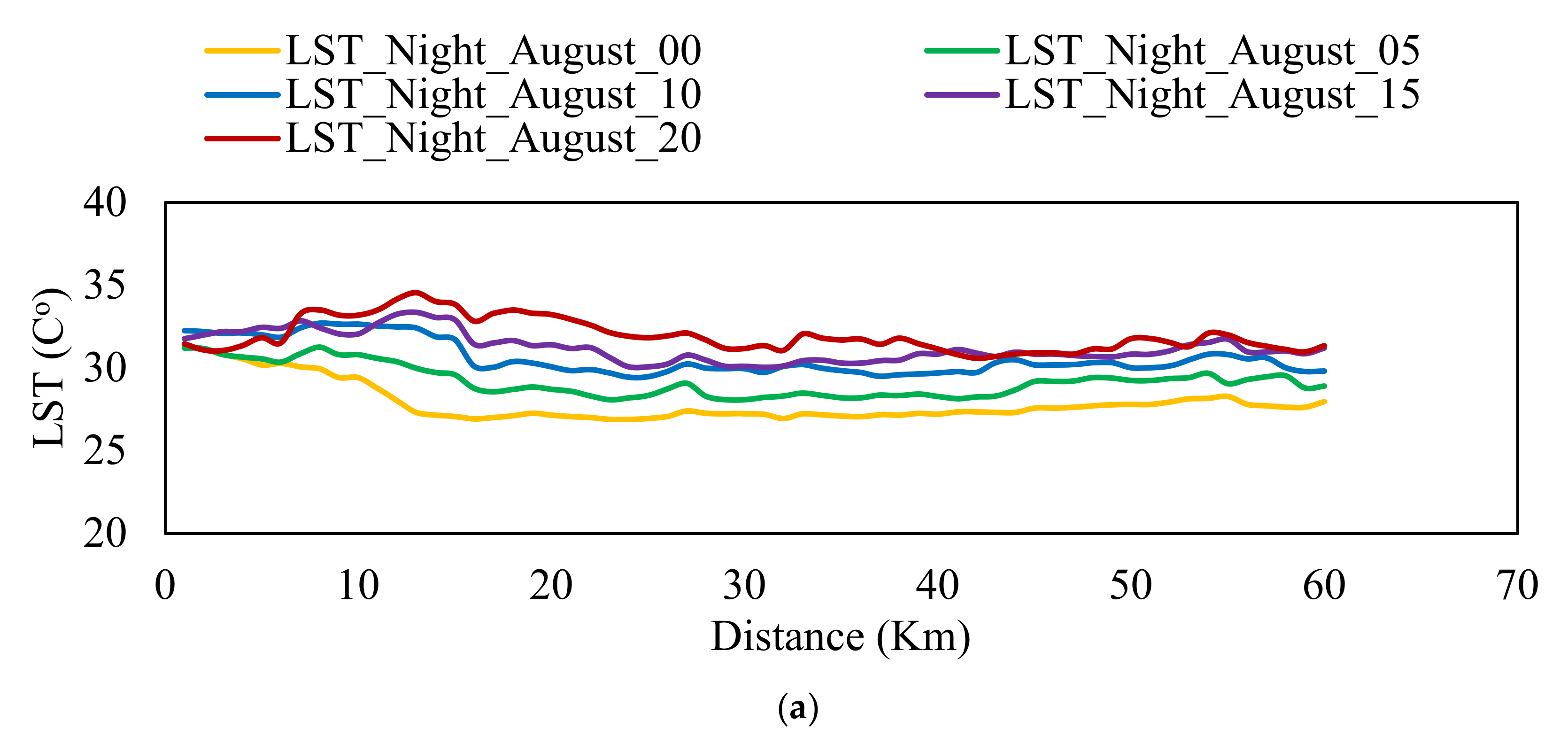
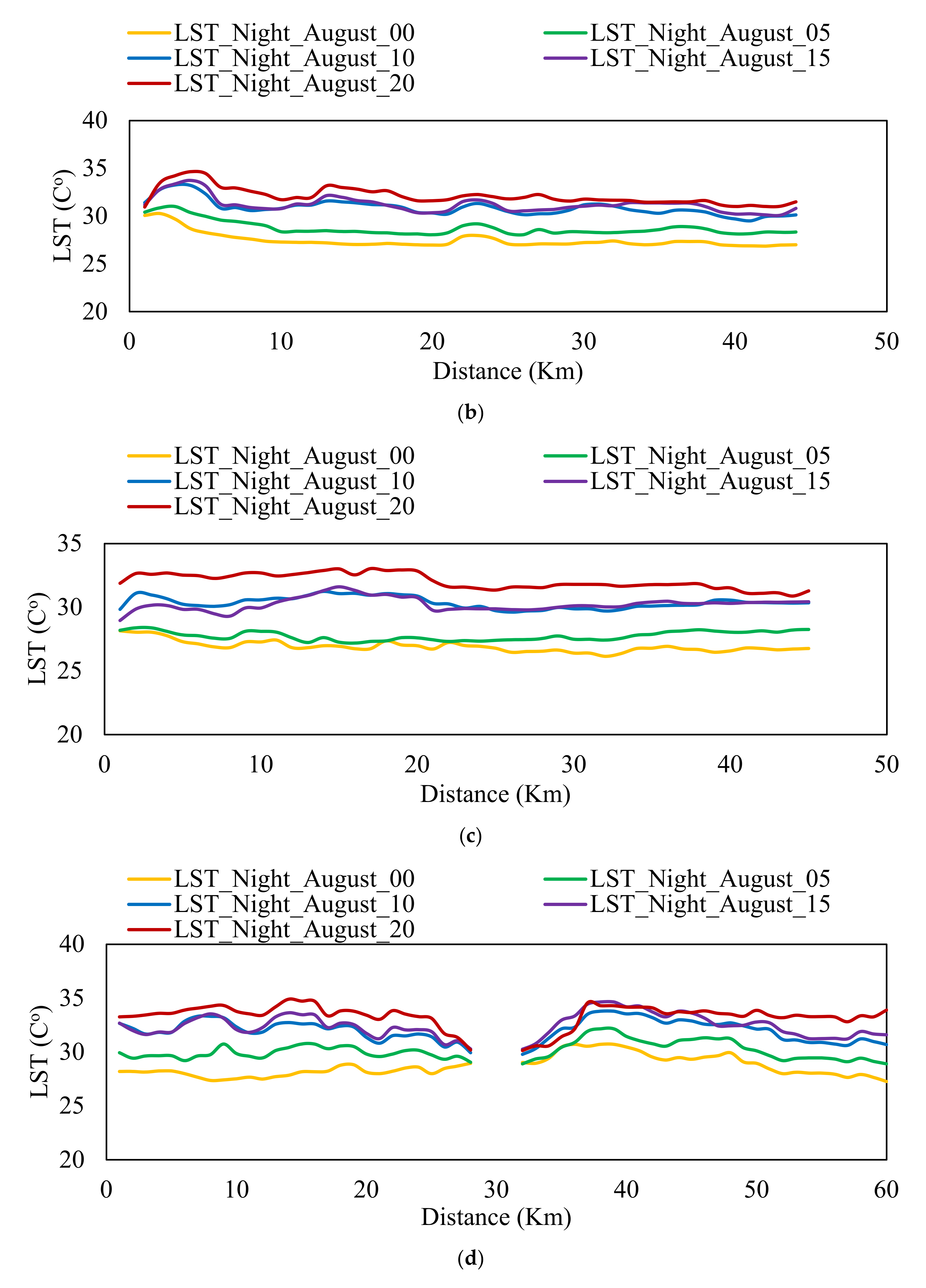
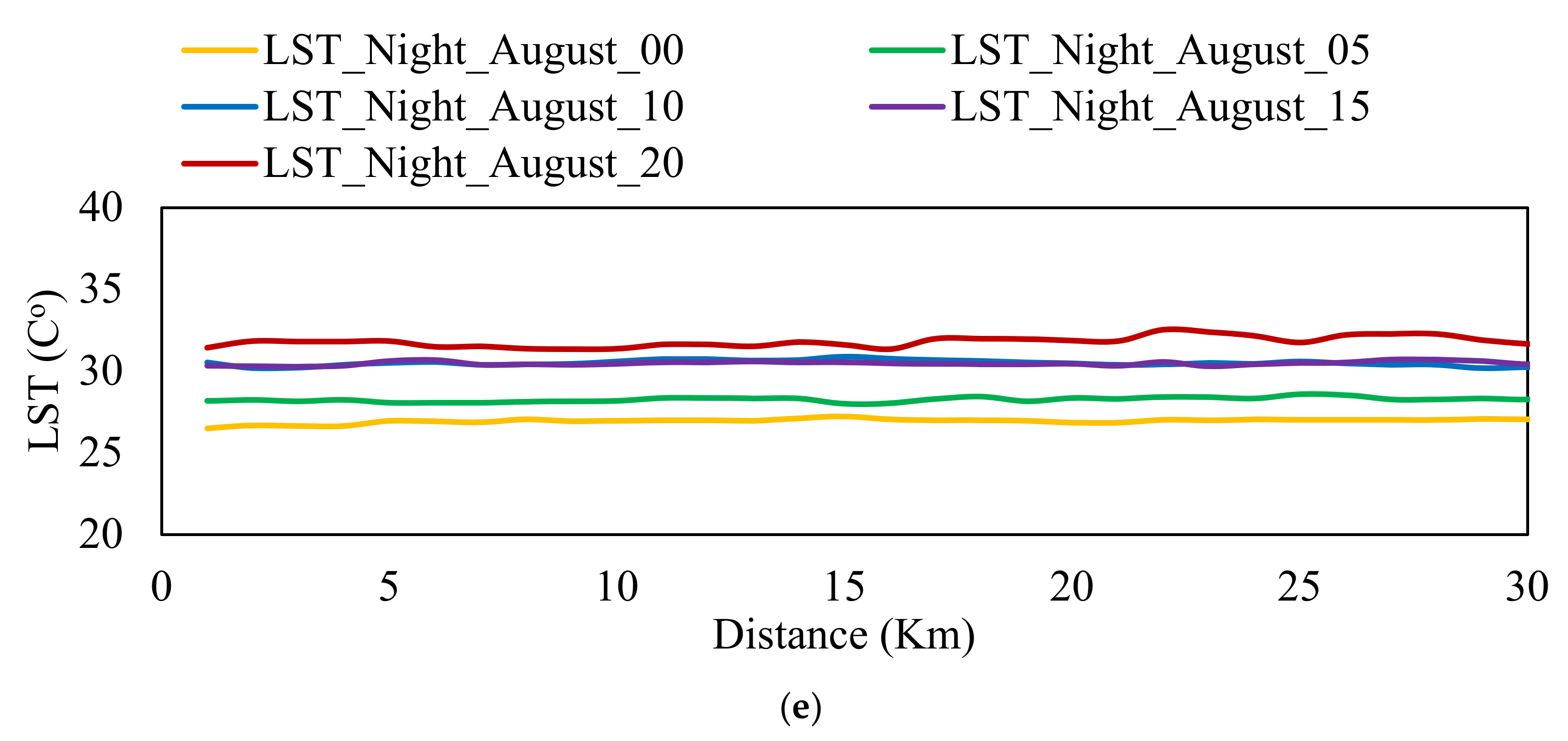
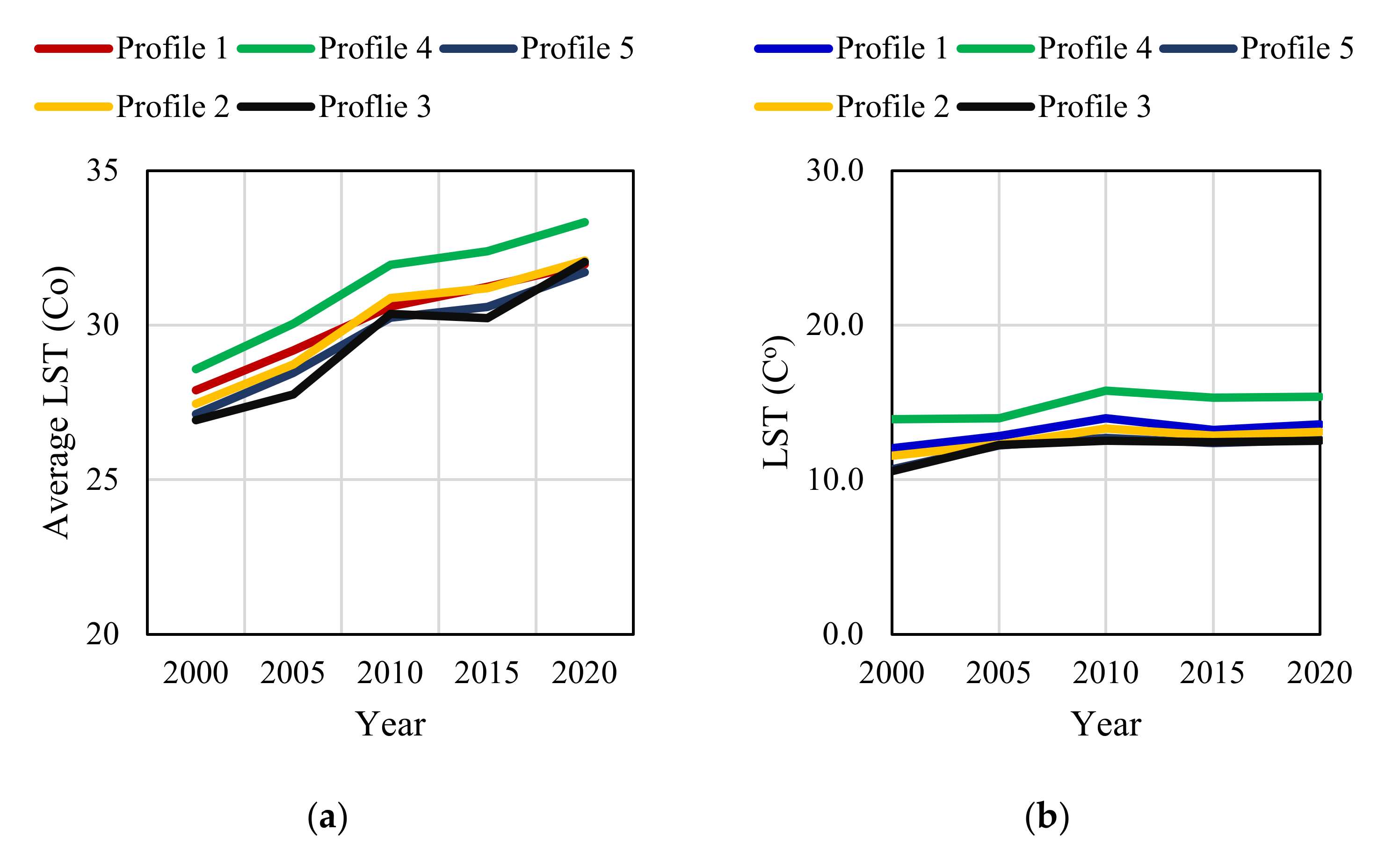
| Class | Bare Soil | Water Bodies | Built-Up Areas | Vegetation | Total | User’s Accuracy |
|---|---|---|---|---|---|---|
| Bare soil | 116 | 0 | 16 | 0 | 132 | 0.88 |
| Water bodies | 1 | 124 | 0 | 0 | 125 | 0.99 |
| Built-up areas | 18 | 0 | 106 | 0 | 124 | 0.85 |
| Vegetation | 4 | 4 | 2 | 109 | 119 | 0.92 |
| Total | 139 | 128 | 124 | 109 | 500 | 0.00 |
| Producer’s Accuracy | 0.83 | 0.97 | 0.85 | 1.00 | 0.00 | 0.91 |
Publisher’s Note: MDPI stays neutral with regard to jurisdictional claims in published maps and institutional affiliations. |
© 2022 by the authors. Licensee MDPI, Basel, Switzerland. This article is an open access article distributed under the terms and conditions of the Creative Commons Attribution (CC BY) license (https://creativecommons.org/licenses/by/4.0/).
Share and Cite
Al-Ruzouq, R.; Shanableh, A.; Khalil, M.A.; Zeiada, W.; Hamad, K.; Abu Dabous, S.; Gibril, M.B.A.; Al-Khayyat, G.; Kaloush, K.E.; Al-Mansoori, S.; et al. Spatial and Temporal Inversion of Land Surface Temperature along Coastal Cities in Arid Regions. Remote Sens. 2022, 14, 1893. https://doi.org/10.3390/rs14081893
Al-Ruzouq R, Shanableh A, Khalil MA, Zeiada W, Hamad K, Abu Dabous S, Gibril MBA, Al-Khayyat G, Kaloush KE, Al-Mansoori S, et al. Spatial and Temporal Inversion of Land Surface Temperature along Coastal Cities in Arid Regions. Remote Sensing. 2022; 14(8):1893. https://doi.org/10.3390/rs14081893
Chicago/Turabian StyleAl-Ruzouq, Rami, Abdallah Shanableh, Mohamad Ali Khalil, Waleed Zeiada, Khaled Hamad, Saleh Abu Dabous, Mohamed Barakat A. Gibril, Ghadeer Al-Khayyat, Kamil E. Kaloush, Saeed Al-Mansoori, and et al. 2022. "Spatial and Temporal Inversion of Land Surface Temperature along Coastal Cities in Arid Regions" Remote Sensing 14, no. 8: 1893. https://doi.org/10.3390/rs14081893









